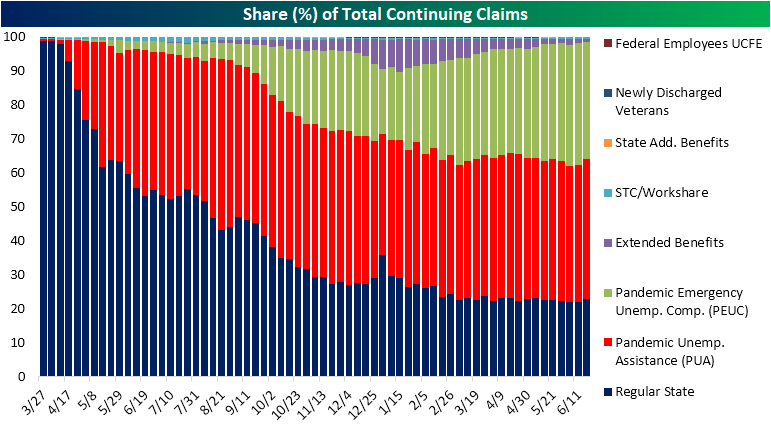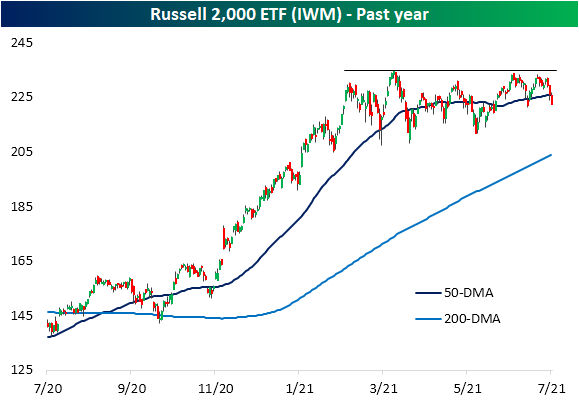Bulls and Bears Retreat
Leading up to the over 1% reversal lower today, the past week has seen the S&P 500 and NASDAQ make a number of new all-time highs. In spite of this, the weekly sentiment survey from AAII showed bullish sentiment give up all of its gains from the prior week as it came in at 40.2%. That is back down to the same level as of June 10th and the 8.4 percentage point decline was the largest since the 10 point drop at the end of April.
Bearish sentiment did not exactly pick up those losses as the reading only rose 2.3 percentage points to 24.5%. That was not a particularly large increase as it only brought bearish sentiment to the highest level in three weeks. While higher sequentially, bearish sentiment remains at the low end of the past several years’ range.
With bulls not becoming bears, neutral sentiment moved higher gaining 6.1 percentage points. At 35.3%, it is still below levels from two weeks ago and is even further below the recent highs that neared 40%. Click here to view Bespoke’s premium membership options.
Chart source: American Association of Individual Investors
B.I.G. Tips – Apple (AAPL) Overbought
Jobless Claims Back to Seasonal Norms
Initial jobless claims disappointed this week rising to 373K versus expectations of a reading 23K lower. Not only was this week’s print higher than expected, but last week’s number was revised up from 364K to 371K. Even though last week’s data was not as strong as it originally appeared to be and this week marked a slight worsening, taking a step back, claims are still at some of the lowest levels of the pandemic and only around 160K above pre-pandemic levels.
On a non-seasonally adjusted basis, claims were again slightly higher rising from 366.5K to 369.7K. While higher, given seasonality trends, this was a notable move. Since 1967, the current week of the year (27th) has only seen UI claims fall week over week once. That decline came last year when claims were coming off of historically elevated levels. While initial claims returned to the usual seasonal pattern this year, it wasn’t by much. Outside of last year, for the 27th week of the year, this past week saw the smallest increase on record.
Turning to the impact of Pandemic Unemployment Assistance (PUA), claims fell back below 100K this week as a handful of more states withdrew from the program. Total claims between the two programs summed to 468.7K this week, dropping week over week but still above the low of 435.8K from the first week of June.
While initial claims disappointed, continuing claims fell week over week and came in below the forecasted reading of 3.35 million. Claims this week totaled 3.339 million, setting a new low for the pandemic which is around twice as high as pre-pandemic levels.
Including all programs into continuing claims counts creates an additional week’s lag in the data meaning the most recent reading is through the week of June 18th. On a combined basis, continuing claims have continued to improve putting in another low at 14.23 million. While they remain the two largest programs accounting for the highest share of total claims, significant declines in PUA and PEUC programs drove that overall decline, offsetting a 53.1K increase in regular state claims. Click here to view Bespoke’s premium membership options.
Chart of the Day: Mega-caps Driving The Bus
B.I.G. Tips – SPY Gaps Down
Bespoke’s Morning Lineup – 7/8/21 – Buckle Up
See what’s driving market performance around the world in today’s Morning Lineup. Bespoke’s Morning Lineup is the best way to start your trading day. Read it now by starting a two-week free trial to Bespoke Premium. CLICK HERE to learn more and start your free trial.
“People don’t pay attention until they have to.” – Meredith Whitney
In yesterday’s email, we noted that “Lower interest rates are good for equity prices, but when the pace of the downside move picks up steam, equity investors take pause.” This morning, we are seeing that trend play out in real-time. As treasury yields continue to plunge, equity investors are reading the rally in the bond market as a sign of weakness ahead and taking profits now. The S&P 500 is currently indicated to open down about 1.25%, and in a sign of just how uniform the decline has been, both the Dow and Nasdaq futures are also in the red by about the exact same amount.
Naturally, all sorts of catalysts are being blamed for the decline ranging from the growing threat of the Delta variant, a weaker than expected economic recovery, or lack of an infrastructure deal. Sometimes, though, the market doesn’t need an excuse to sell off and it just needs to let off some steam.
In economic news, the only major data point of the day is initial jobless claims which came in 23K above forecasts (373K vs 350k). Continuing claims, however, managed to fall more than expected falling to a post COVID low of 3.339 million.
Read today’s Morning Lineup for a recap of all the major market news and events from around the world, a discussion of growth in the Delta variant, economic data from around the world, the latest US and international COVID trends including our vaccination trackers, and much more.
There was a time not long ago when a number of sentiment indicators showed a healthy degree of skepticism on the part of investors. That time is no longer. One indicator we don’t highlight on a regular basis is the TD Ameritrade Investor Movement Index (IMX). Calculated by TD Ameritrade, the IMX is designed to measure individual investor sentiment based on what investors are actually doing in their brokerage accounts.
Back near the 2020 lows, the IMX index dropped to its lowest level since early 2012 and while it bounced with the overall market when the S&P 500 was back at all-time highs last September, it was much slower to recover and well below its record highs from late 2017. Since the start of this year, though, investor sentiment has really started to surge, rising from 5.49 last November to a record 9.08 in June. In the eleven years that TD Ameritrade has been publishing this index, it has never seen as sharp of a surge as it has over the last several months.

Daily Sector Snapshot — 7/7/21
Chart of the Day: Ditching Trading for the Open Ocean
Mega Cap Stocks Relatively Strong
Mega cap stocks are an important area to watch and have been an area of our focus recently as the relatively small number of names hold a large weight within the S&P 500. Their recent strength has propelled the broad market to a series of new highs in spite of what has been weaker breadth outside of this space.
In the chart below, we take a closer look at the relative performance of the four largest stocks versus the S&P 500 over the past year. Alphabet (GOOGL) has performed the best versus the S&P 500 of the four names shown and is at one-year highs. Apple (AAPL) outperformed the S&P significantly in 2020 but gave it all back from late January through May. Since June, however, Apple has been on a tear versus the market. Microsoft (MSFT) and Amazon (AMZN) are both still underperforming the S&P over the last twelve months, but they have made solid moves higher since June. Click here to view all of Bespoke’s premium membership options and to sign up for a trial.
Russell 2,000 (IWM) No Longer in Favor
The final quarter of 2020 and the first quarter of this year saw small caps come back into favor as the Russell 2,000 consistently outperformed the S&P 500 during that stretch. From the late September test of its 200-DMA to the mid-March highs, the Russell 2,000 rose rallied around 65% versus the S&P 500’s gain which was less than half of that. As such, the ratio of the two indices shown below, and highlighted in last night’s Closer, ripped higher. That outperformance has been absent over the past quarter though. In the second half of March, the ratio peaked then made a sharp reversal lower. Throughout Q2 and continuing into Q3, the ratio has continued to trend lower as the Russell 2,000 has trended sideways, hovering around its 50-DMA. Click here to view all of Bespoke’s premium membership options and to sign up for a trial.












